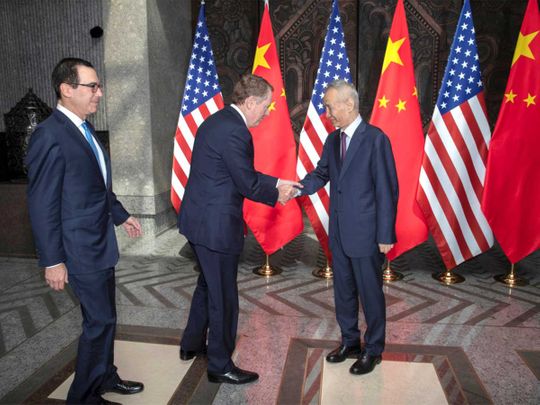
Over the past several days, major stock indices around the world have seen a drop in their values as a result of the trade standoff between the United States and China. In Washington, President Donald Trump announced $300 billion (Dh1.1 trillion) in new tariffs, in addition to the $250 billion that have been in place for the past six months.
This trade dispute is marked by tit-for-tat retaliatory measures, with Beijing saying it would no longer purchase American farm exports. In addition, those responsible for fiscal policy in the world’s second-largest economy have ceased to take measures to maintain the yuan-to-dollar rates, allowing the Chinese currency to fall to the rate of seven to one.
The administration in Washington is now accusing Beijing of currency manipulation, a designation that has technical overtones with eventual punitive measures should that accusation hold water. This dispute between Washington and Beijing has been simmering, and now that the yuan has been brought into the dispute adds another dimension that demonstrates the short-sightedness of tariffs.
Power of tariffs
Tariffs were introduced as a measure to try and curb the reach of Chinese products, making those imports more expensive for American consumers, protecting US manufacturers and retailers from the cheaper and more abundant Chinese products. With Beijing removing the controls on keeping the yuan at previous levels, China’s currency has fallen. A lower yuan makes Chinese goods and products cheaper to buy in the US — offsetting the tariffs’ power to make Chinese goods more pricey.
From an economic standpoint, this dispute between the world’s two largest economies makes little sense. The reality is that global trade is now so coordinated and interdependent that the power of tariffs has been lessened dramatically. And when currency values are added into the equation, the power of tariffs is reduced further.
In the UAE, our growth and prosperity has been built to a great extent from our focal point between east and west, north and south — a key location that benefits from global trade. Tariffs are impediments to free trade and movement of goods around the world. They disrupt the stability that allows trade and commerce to prosper. Similarly, stability in currency levels also assists free and easy flow of trade and commerce.
Later this month, at Biarritz in France, the G7 leaders will meet for talks — a perfect opportunity for Trump and Chinese President Xi Jinping to work on their trade and currency issues.







